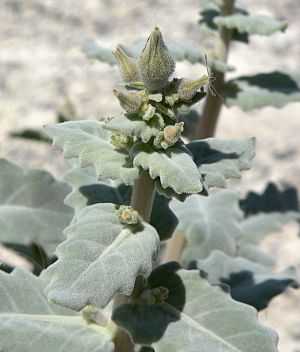Ash Meadows blazingstar facts for kids
Quick facts for kids Ash Meadows blazingstar |
|
|---|---|
 |
|
| Conservation status | |
| Scientific classification | |
| Genus: |
Mentzelia
|
| Species: |
leucophylla
|
Mentzelia leucophylla, also known as the Ash Meadows blazingstar, is a special kind of flowering plant. It is very rare and only grows in one small area. This plant is found only in southwestern Nevada, in the United States.
Where Does It Live?
This rare plant lives only in southern Nye County, Nevada. It is one of many unique plants found in a place called Ash Meadows. Ash Meadows is a desert area with special wetlands. These wetlands have a unique ecosystem (a community of living things and their environment). The Ash Meadows blazingstar is in danger because its home is being damaged. Because of this, it is listed as a threatened species by the government.
What Does It Look Like?
The Ash Meadows blazingstar is a plant that grows for two years (biennial) or more (perennial). It can grow up to about 1.5 feet (0.5 meters) tall. Its stem and leaves are covered in tiny white hairs. This makes the plant look pale and feel soft, almost like velvet.
The plant has many bright yellow flowers. These flowers bloom from May through September. They open for only a short time in the afternoon.
About Ash Meadows
Ash Meadows is a special part of the desert. It has many wet areas like springs and seeps. These wet spots get their water from groundwater (water found underground). This water helps many different plants and animals to live there. Some of these plants and animals are very rare. They are found only in Ash Meadows.
For example, the Ash Meadows milkvetch and the Ash Meadows sunray grow here. They grow alongside the Ash Meadows blazingstar. A large part of this special habitat is protected. It is part of the Ash Meadows National Wildlife Refuge. This refuge is a unit of the larger Desert National Wildlife Refuge Complex.
The ground in Ash Meadows is made of fine sand and clay. It often has a salt crust on top. The soil is also alkaline, which means it is not acidic. Plants that like salty soil, like shadscale, grow well here.
Over many years, people have disturbed the Ash Meadows area. This includes digging for peat (a type of soil). Roads were built, and land was developed for homes. Farming activities also caused problems. These included plowing, changing water flow, and allowing animals to graze. Pumping groundwater was a big threat. It lowered the water level that keeps the ecosystem alive.
See also
 In Spanish: Mentzelia leucophylla para niños
In Spanish: Mentzelia leucophylla para niños


